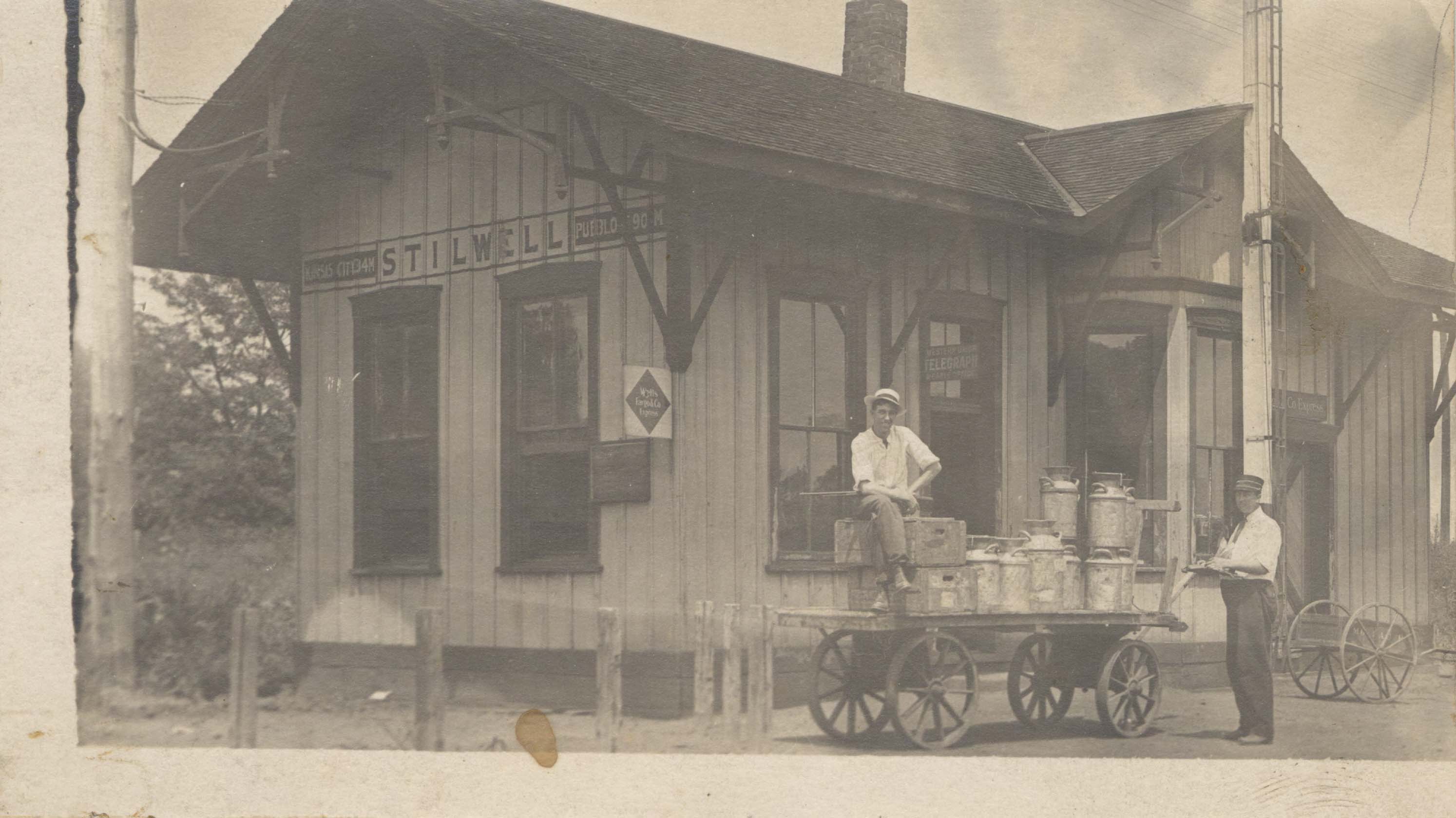Guest written by: Jessica Sapien, Emerging Museum Professional Intern, Johnson County Museum In 2020, the Johnson County Museum asked members of the Olathe Leadership Lowrider Bike Club to make a bike that represents the club, its values, and its...
Guest written by: Jessica Sapien, Emerging Museum Professional Intern, Johnson County Museum
In 2020, the Johnson County Museum asked members of the Olathe Leadership Lowrider Bike Club to make a bike that represents the club, its values, and its culture. The lowrider bike and interpretive labels will be unveiled Wednesday, October 4th at the Johnson County Arts & Heritage Center’s Hispanic Heritage Month Celebration. Read on to learn more about the history of the Lowrider Bike Club and of lowriding!
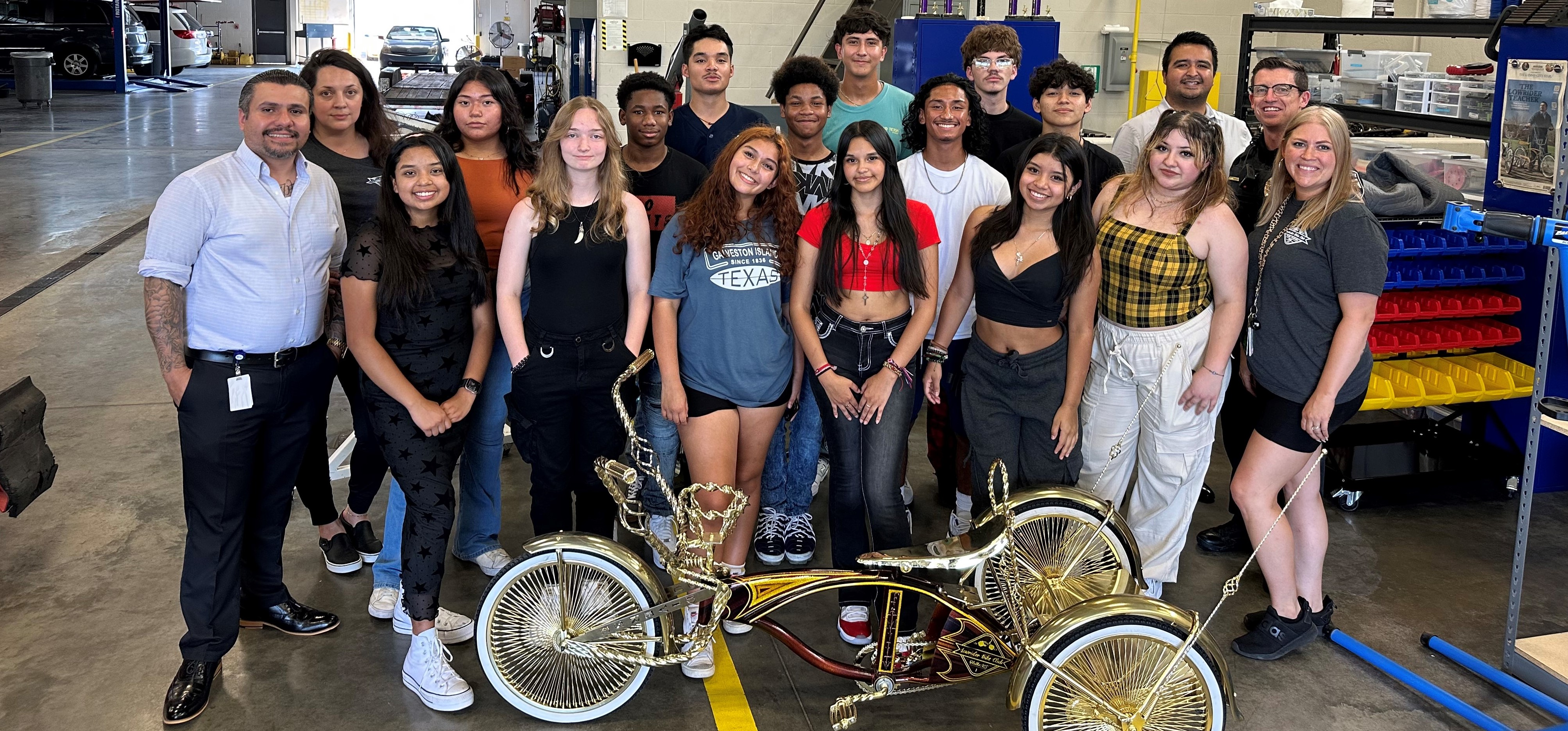 Olathe Lowrider Bike Club members in their shop in 2023. Club founder, Erik Erazo, stands on the far left.
Olathe Lowrider Bike Club members in their shop in 2023. Club founder, Erik Erazo, stands on the far left.
The Lowrider Bike Club
Erik Erazo founded the Olathe Leadership Lowrider Bike Club in 2016 and launched it the following year. Erazo, who is the Executive Director of Student and Community Engagement for Olathe Public Schools, initially started the club to reach at-risk Hispanic male students. Six years later, the club is open to all students who seek mentorship and community through the bike building process.
The club provides a space for students to gather and share their individual and familial experiences while learning valuable technical skills. The Lowrider Bike Club is run out of the Olathe Advanced Technical Center where students have a dedicated workplace to meet. Club members receive a bike kit their freshman year and are taught the artistic process of creating and customizing lowrider bikes. They are allowed to keep their bikes upon their graduation.
In its first seven years of operation, the Lowrider Bike Club boasts a 100% graduation rate. This success has led eight other schools across the United States to form their own chapters of the Lowrider Bike Club, including three in Kansas City, Kansas, and Missouri. Members of the founding chapter participate in lowrider shows throughout the state, with some graduates going on to compete nationally.
“It gives me a state of mind where I’m myself. Where I can express my own feelings, whether it be that day, that week, or that month, I can put it into the bike. Whether it’s releasing anger, putting my frustrations into the bike, or something even positive like my happiness. If I’m having a good day, I put that into the bike. That’s a really good outlet for me in this club and it also gives me a good high school experience as I get to talk to people I’ve never talked to before. I get to meet upperclassmen and I get to inspire lowerclassmen to work harder and do better… it’s a really good experience and it really means a lot to me.”
– Miguel Santillanes, student in the Olathe Leadership Lowrider Bike Club
The Lowrider Bike
The lowrider bike customized by the students of the Olathe Leadership Lowrider Bike Club is both traditional and unique in its design. It features extended handlebars, a twisted gold chrome steering wheel, antennas, and other accents. Making the bike required new skills to make their vision a reality – including upholstery! With help from an officer of the Olathe Police Department, students learned how to upholster to create the seat on the back of the bike.
The bike is painted brown with a glitter finish to represent the warmth and coming together of all club members, and gold accents represent the club’s success and achievements. Laser cut into the design are the words Culture, Family, and Diversity, representing the club’s values. The frame between the back wheels includes the Olathe Leadership Lowrider Bike Club’s logo.

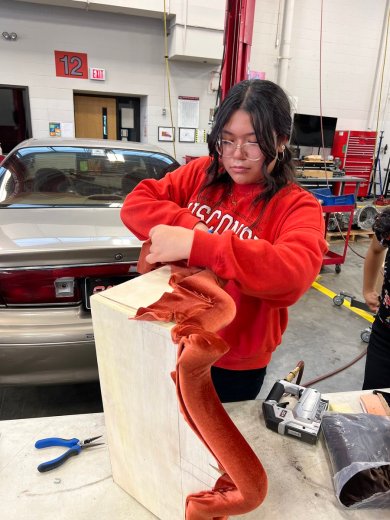
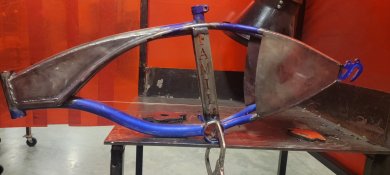
Club members work on customizing details for the lowrider bike.
Lowrider Culture
Lowrider cars and bikes are as unique as the artist or artists who customized them. The lowrider not only serves as a representation of the artist, but of their community and culture. Lowriding in the Kansas City Metro area can be traced back to the 1950s. The growing Mexican American and Latino populations, car clubs, and shows – also known as Show N’ Shines – have increased the popularity of lowriding in the area. In 1995, the national Lowrider magazine held a lowriding competition in Kansas City, Missouri. In 1996, the magazine included Kansas City as one of its 15 stops on its 20th Anniversary Tour. Since then, the number of shows has continued to grow, and lowrider clubs participate in cultural and community events throughout the Metro area.
Lowrider culture emerged in Chicano communities in California and Texas after World War II as a form of both self and cultural expression, as well as community making. Chicanos artistically modified their vehicles with various accents including chrome, velvet, hydraulic suspensions, vivid paint jobs, and murals. These vehicles drove low and slow as lowriders cruised around neighborhoods allowing adults and children to admire and connect with the visual representation of Mexican American culture. Chicano youth wanted to have cars like their parents, siblings, or neighbors, and began customizing their bikes to look like lowrider cars. This is why many bikes feature iconic lowrider car parts, such as steering wheels, exhaust pipes, and antennas.
“What the Lowrider Bike Club means to me is family. That’s the most important thing to me. It’s my second family. And I am really thankful for them because they taught me so many things throughout these two years that I’ve been here. We’re showing off culture. No matter if you’re not from exactly where it was based on … we want to show the people that are coming to visit the Johnson County Museum about the culture, and the art, and how much time we have spent together to build this bike.”
-Stephanie Garcia Rios, student in the Olathe Leadership Lowrider Bike Club
Lowrider culture borrows and blends with pachucos/as and zoot suiters, whose flamboyant style was also popularized after WWII. Lowriding was criminalized in many areas throughout the U.S. because of the increased politization of the Chicano identity in the postwar era. Certain car modifications were outlawed, and no-cruising zones were established to restrict the areas where lowriders could drive. This caused tension with local police departments, who targeted Brown and Black lowriders. The Chicano Movement of the 1960s aimed to redefine Mexican American’s place in the United States, which included challenging discriminatory and often violent practices. Today, however, the Olathe Leadership Lowrider Bike Club closely partners with the Olathe Police Department to offer resources and mentorship to the club’s students.
A New Display
The new Lowrider Bike Club bike will be on display in the Becoming Johnson County exhibit beginning October 5 – come check it out! The Museum’s goal is to ensure that the range of Latino/a experiences in Johnson County, Kansas, and the greater United States are represented in our exhibits and collections. The bike will be a centerpiece of the Museum’s Latino Collecting Initiative, which the Museum launched four years ago as part of its strategic effort to connect with Johnson County’s historic and growing Latino/a community. With over 200 years of history on this landscape, Museum staff acknowledges the county’s Latino community is underrepresented in our exhibits and in our collection. Through the Latino Collecting Initiative and the trust partners place in the Museum to tell a fuller and more inclusive history, the Museum is thrilled to say the community is helping to change that. The Museum is honored to partner with the Olathe Leadership Lowrider Bike Club to have this customized bike on display. We hope this artifact inspires Johnson County’s Latino/a community to continue sharing stories with the Museum that represent themselves, their families, and their community.
Jessica Sapien is a Master’s student in the UMKC Public History emphasis. She is in her second year of the Emerging Museum Professional internship at the Johnson County Museum. The internship experience is generously supported by the Carter Community Memorial Trust, UMB Bank, n.a., Trustee; Geraldine and R A Barrows Foundation, UMB Bank, n.a., Trustee; JE Dunn; and the Friends of the Johnson County Museum.
El Club de Liderazgo y Bicicletas Lowrider de Olathe
Escritor invitado: Jessica Sapien, Pasante Profesional Emergente, Museo del Condado Johnson
En el 2020, el Museo del Condado de Johnson le preguntó a miembros del Club de Liderazgo y Bicicletas Lowrider de Olathe si podían construir una bicicleta que representara los valores y la cultura del club. La bicicleta lowrider y los paneles interpretativos se darán a conocer el miércoles, 4 de octubre en el Centro de Artes y Cultura del Condado Johnson durante la celebración del Mes de la Herencia Hispana. ¡Sigua leyendo para saber más acerca de la historia del Club de Bicicletas Lowrider y del “lowriding”!
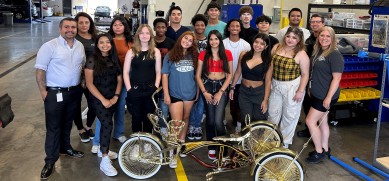
Miembros del Club de Bicicletas Lowrider de Olathe en su taller en el 2023. Fundador del Club, Erik Erazo, se encuentra en la extrema izquierda.
El Club de Bicicletas Lowrider
Erik Erazo fundó el Club de Liderazgo y Bicicletas Lowrider de Olathe en 2016 y lo lanzó al año siguiente. Erazo, quien es el director ejecutivo de Participación Estudiantil y Comunitaria de las Escuelas Públicas de Olathe, inicialmente comenzó el club para llegar a los estudiantes varones hispanos en riesgo. Seis años después, el club está abierto a todos los estudiantes que buscan tutoría y comunidad a través del proceso de construcción de bicicletas.
El club atiende a la creciente población hispana de Olathe, proporcionando un espacio para que los estudiantes se reúnan y compartan sus experiencias individuales y familiares mientras aprenden valiosas habilidades técnicas. Los miembros del club reciben un kit de bicicleta en su primer año y se les enseña el proceso artístico de crear y personalizar bicicletas lowrider. Se les permite quedarse con sus bicicletas después de su graduación.
En sus primeros siete años, el Club de Liderazgo y Bicicletas Lowrider de Olathe alardeó una tasa de graduación de 100%. Este éxito ha llevado a otras ocho escuelas en los Estados Unidos a formar sus propios capítulos, incluyendo tres otros en el área metropolitana de Kansas City. Los estudiantes del Club de Liderazgo y Bicicletas Lowrider de Olathe participan al presente en exhibiciones de lowrider a través de todo el estado, y algunos graduados han competido a nivel nacional.
“Me da un estado mental de donde me encuentro en el momento. Donde puedo expresar mis propios sentimientos, ya sea ese día, esa semana o ese mes, puedo ponerlo en la bicicleta. Ya sea liberando la ira, poniendo mis frustraciones en la bicicleta, o algo incluso positivo como mi felicidad. Si estoy teniendo un buen día, lo pongo en la bicicleta. Esa es una muy buena salida para mí en este club y también me da una buena experiencia en la escuela secundaria, ya que puedo hablar con personas con las que nunca he hablado antes. Tengo la oportunidad de conocer a estudiantes de último año e inspirar a los estudiantes de grados más bajos a trabajar más duro y hacerlo mejor … Ha sido una experiencia realmente buena y muy significativa para mí”.
– Miguel Santillanes, alumno del Club de Liderazgo y Bicicletas Lowrider de Olathe
La bicicleta lowrider
La bicicleta lowrider personalizada por los estudiantes del Club de Bicicletas Lowrider de Olathe.es tradicional y única en su diseño. Cuenta con manillares extendidos, un volante de cromo dorado retorcido, antenas y otros acentos. Construir la bicicleta requirió nuevas habilidades para hacer realidad su visión, ¡incluida la tapicería! Con la ayuda de un oficial del Departamento de Policía de Olathe, los estudiantes aprendieron a tapizar para crear el asiento en la parte trasera de la bicicleta.
La bicicleta está pintada de marrón con un acabado brillante para representar la calidez y la unión de todos los miembros del club, y los acentos dorados representan el éxito y los logros del club. Cortadas con láser en el diseño están las palabras Cultura, Familia y Diversidad, que representan los valores del club. El cuadro entre las ruedas trasras incluye el logotipo del Club de Liderazgo y Bicicletas Lowrider de Olathe.



Los miembros del club trabajan en la personalización de los detalles de la bicicleta lowrider.
La cultura lowrider
Los autos y bicicletas lowrider son tan únicos como el artista o artistas que los personalizaron. El lowrider no solo sirve como una representación del artista, sino de su comunidad y cultura. Lowriding en el área metropolitana de Kansas City se remonta a la década de 1950. Las crecientes poblaciones mexicoamericanas y latinas, los clubes de automóviles y los espectáculos, también conocidos como “Show N ‘Shines”, han aumentado la popularidad del lowriding en el área. En 1995, la revista nacional Lowrider celebró una competencia de lowriding en Kansas City, Missouri. En 1996, la revista incluyó a Kansas City como una de sus 15 paradas en su gira del 20 aniversario. Desde entonces, el número de espectáculos ha seguido creciendo, y los clubes lowrider participan en eventos culturales y comunitarios en toda el área metropolitana.
La cultura lowrider surgió en las comunidades chicanas de California y Texas después de la Segunda Guerra Mundial como una forma de expresión personal y cultural, y ayudo a crear un sentido de comunidad. Los chicanos modificaron artísticamente sus vehículos con varios acentos decorativos que incluyen volantes de cromo, tapizado de terciopelo, suspensiones hidráulicas, trabajos de pintura vívidos y murales. Estos vehículos conducían bajo y lentamente mientras los lowriders recorrían vecindarios para que adultos y niños admiraran y se conectaran con representaciones visuales de la cultura mexicoamericana. Los jóvenes chicanos querían tener autos como sus padres, hermanos o vecinos, y comenzaron a personalizar sus bicicletas para que parecieran autos lowrider. Ésta es la razón por la que muchas bicicletas cuentan con piezas icónicas de automóviles lowrider, como volantes cromados, tubos de escape y antenas.
“Lo que el Club de Bicicletas Lowrider significa para mí es familia. Es lo más importante para mí. Es mi segunda familia. Estoy muy agradecida por ellos porque me enseñaron tantas cosas a lo largo de estos dos años que he estado aquí. Estamos mostrando cultura. No importa si no eres exactamente de donde esa cultura se basó … queremos mostrar a las personas que vienen a visitar el Museo del Condado de Johnson sobre la cultura y el arte, y cuánto tiempo hemos pasado juntos para construir esta bicicleta”.
-Stephanie García Ríos, estudiante parte del Club de Liderazgo y Bicicletas Lowrider de Olathe
La cultura lowrider toma prestado y se mezcla con los pachucos o “zoot suiters” cuyo estilo extravagante también se popularizó después de la Segunda Guerra Mundial. “Lowriding” fue criminalizado en muchas áreas de los Estados Unidos debido a la creciente politización de la identidad chicana en la era de la posguerra. Se prohibieron ciertas modificaciones de automóviles y se establecieron zonas no transitables para restringir las áreas donde los lowriders podían conducir. Esto causó tensión con los departamentos de policía locales, que apuntaron a los lowriders latinos y negros. El Movimiento Chicano de la década de 1960 tenía como objetivo redefinir el lugar de los mexicoamericanos en los Estados Unidos, lo que incluía desafiar las prácticas discriminatorias y la violencia que enfrentaban. Hoy, sin embargo, el Club de Liderazgo y Bicicletas Lowrider de Olathe se asocia estrechamente con el Departamento de Policía de Olathe ya que ofrece recursos y tutoría a los estudiantes del club.
Un nuevo artefacto
La nueva bicicleta lowrider estará en exposición en la exhibición “Becoming Johnson County” apartir del 5 de octubre, ¡pasen a verla! El objetivo del Museo es garantizar que la gama de experiencias latinas en el Condado de Johnson, Kansas y los Estados Unidos estén representadas en nuestras exhibiciones y colecciones. La bicicleta será una pieza central de la Iniciativa de Coleccionismo Latino del museo, que el museo lanzó hace tres años como parte de su esfuerzo estratégico para conectarse con la histórica y creciente comunidad latina del Condado de Johnson. Con más de 200 años de historia en esta región el personal del museo reconoce que la comunidad latina del condado no está resentada en nuestras exhibiciones y en nuestra colección. A través de la Iniciativa de Coleccionismo Latino y la confianza que la comunidad deposita en el museo, esperamos contar una historia más completa e inclusiva. El museo está encantado de decir que la comunidad está ayudando a cambiar eso. El museo tiene el honor de asociarse con el Club de Liderazgo y Bicicletas Lowrider de Olathe para exhibir esta bicicleta personalizada. Esperamos que este artefacto inspire a la comunidad latina del Condado de Johnson a continuar compartiendo historias con el museo que los representen a sí mismos, a sus familias y a su comunidad.
Jessica Sapien es estudiante de maestría con énfasis en Historia Pública de UMKC. Se encuentra en su segundo año de la pasantía profesional del Museo Emergente en el Museo del Condado de Johnson. La experiencia de la pasantía cuenta con el generoso apoyo del Carter Community Memorial Trust, UMB Bank, n.a., Fideicomisario; Geraldine and R A Barrows Foundation, UMB Bank, n.a., Fideicomisario; JE Dunn; y los Amigos del Museo del Condado de Johnson.





